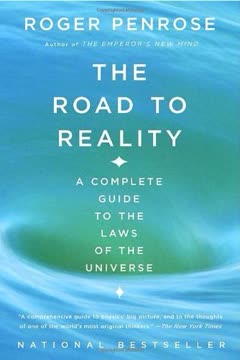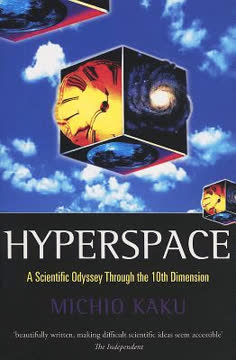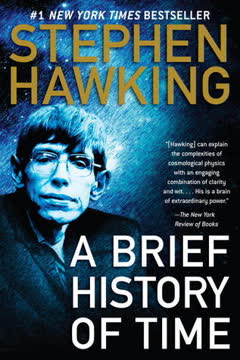Key Takeaways
1. The Universe Began as an Incredibly Hot and Dense State
"In the beginning there was an explosion. Not an explosion like those familiar on earth, starting from a definite centre and spreading out to engulf more and more of the circumambient air, but an explosion which occurred simultaneously everywhere, filling all space from the beginning, with every particle of matter rushing apart from every other particle."
Explosive Beginning. The universe's origin is not like conventional explosions, but a simultaneous expansion occurring everywhere. At its inception, the universe was unimaginably hot and dense, with temperatures reaching hundreds of millions of degrees and particles interacting at incredible speeds.
Thermal Equilibrium. In these earliest moments, the universe was in a state of near-perfect thermal equilibrium. Particles continuously collided and interacted, maintaining a balance that determined the fundamental properties of matter and energy. This equilibrium allowed physicists to predict the universe's early conditions with remarkable precision.
Fundamental Particles. The early universe contained a soup of fundamental particles:
- Photons (light particles)
- Electrons and positrons
- Neutrinos and antineutrinos
- Protons and neutrons in small quantities
2. Galaxies Are Expanding Away from Each Other
"The universe is expanding uniformly and isotropically - the same pattern of flow is seen by observers in all typical galaxies, and in all directions."
Cosmic Expansion. Galaxies are not stationary but moving apart at speeds proportional to their distance. This expansion was first discovered through spectroscopic observations of galactic red shifts, indicating that more distant galaxies are moving away faster.
Hubble's Law. The relationship between a galaxy's distance and its recession velocity is known as Hubble's Law. This fundamental principle suggests that the universe is continuously expanding, with galaxies moving away from each other at increasing speeds.
Observational Evidence:
- Spectral line shifts towards red wavelengths
- Proportional velocities of distant galaxies
- Consistent expansion pattern across observable universe
3. Cosmic Microwave Radiation Reveals the Universe's Early History
"The effort to understand the universe is one of the very few things that lifts human life a little above the level of farce, and gives it some of the grace of tragedy."
Radiation Background. The cosmic microwave radiation, discovered accidentally in 1965, provides crucial evidence about the universe's early state. This uniform background radiation represents remnant heat from the time when the universe became transparent, approximately 700,000 years after its beginning.
Temperature Insights. The radiation's temperature of approximately 3 degrees Kelvin allows scientists to reconstruct the universe's early conditions. By analyzing this radiation, researchers can calculate the ratio of photons to nuclear particles and understand the fundamental composition of the early universe.
Significance of Discovery:
- Confirmed the Big Bang theory
- Provided empirical evidence for cosmic evolution
- Allowed precise calculations of early universal conditions
4. The First Three Minutes Determined the Universe's Fundamental Composition
"At the end of the first three minutes the contents of the universe were mostly in the form of light, neutrinos, and antineutrinos."
Nucleosynthesis Process. During the first three minutes, fundamental nuclear reactions occurred that determined the universe's elemental composition. Specifically, this period produced approximately 75% hydrogen and 25% helium, which would become the primary building blocks of stars and galaxies.
Critical Temperature Conditions. The universe's temperature and density during these initial minutes were crucial in determining which nuclear reactions could occur. As the universe cooled and expanded, protons and neutrons combined to form light atomic nuclei.
Elemental Formation Highlights:
- Hydrogen remained the most abundant element
- Helium formed through rapid nuclear reactions
- Trace amounts of deuterium and other light elements created
5. Particle Physics Explains the Early Universe's Extraordinary Conditions
"At temperatures above a threshold of fifteen hundred thousand million degrees Kelvin, the universe would contain large numbers of the particles known as pi mesons."
Particle Interactions. The early universe's extreme conditions allowed for unique particle interactions impossible to reproduce in current laboratory settings. Particles existed in thermal equilibrium, continuously creating and annihilating each other.
Quantum Mechanics Insights. Quantum theory explains how particles behaved at incredibly high temperatures, revealing the universe's fundamental symmetries and interactions. These interactions determined the basic structure of matter and energy.
Particle Behavior Characteristics:
- Continuous creation and destruction
- Thermal equilibrium maintenance
- Complex interaction patterns
- Rapid energy exchanges
6. The Universe's Future Depends on Its Current Density
"If the cosmic density is less than the critical density, then the universe is of infinite extent and will go on expanding for ever."
Expansion Scenarios. The universe's ultimate fate hinges on its current matter density. If density is below a critical threshold, the universe will continue expanding indefinitely; if above, it will eventually contract.
Potential Cosmic Futures. Depending on density, the universe might experience endless expansion, eventual contraction, or potentially oscillate between expansion and contraction. Each scenario presents profound implications for cosmic evolution.
Density Outcome Possibilities:
- Infinite, ever-expanding universe
- Finite universe with eventual contraction
- Potential cyclic expansion-contraction model
7. Scientific Curiosity Elevates Human Understanding
"The effort to understand the universe is one of the very few things that lifts human life a little above the level of farce, and gives it some of the grace of tragedy."
Intellectual Exploration. Scientific inquiry represents humanity's most noble pursuit of understanding. By systematically investigating the universe's origins and mechanics, humans transcend mundane existence and engage with profound existential questions.
Philosophical Significance. The scientific method allows humans to move beyond mythological explanations, providing empirical insights into cosmic processes. This approach represents a triumph of rational thought over supernatural interpretations.
Research Motivations:
- Expanding human knowledge
- Challenging existing paradigms
- Pursuing fundamental truths
8. The Early Universe Exhibited Remarkable Symmetry and Simplicity
"Nature now exhibits a great diversity of types of particles and types of interactions. Yet we have learned to look beneath this diversity, to try to see the various particles and interactions as aspects of a simple unified gauge field theory."
Fundamental Symmetries. The early universe displayed an underlying simplicity and symmetry now obscured by cosmic cooling. High-temperature conditions allowed fundamental forces to appear more unified and interconnected.
Particle Interactions. At extreme temperatures, different particle interactions were less differentiated, suggesting a more fundamental, unified description of natural forces potentially exists.
Symmetry Characteristics:
- Unified fundamental forces
- Simplified particle interactions
- Minimal complexity at high temperatures
9. Gravitational and Quantum Interactions Remain Mysterious
"We do not know enough about the quantum nature of gravitation even to speculate intelligently about the history of the universe before this time."
Theoretical Limitations. Current physics cannot fully explain gravitational and quantum interactions at the universe's earliest moments. These fundamental uncertainties represent significant gaps in scientific understanding.
Complexity of Fundamental Forces. The extreme conditions of the universe's beginning challenge existing theoretical frameworks, highlighting the limitations of current scientific knowledge.
Research Frontiers:
- Quantum gravity theories
- Extreme condition physics
- Fundamental force unification
10. The Universe's Origin Challenges Human Comprehension
"It is almost irresistible for humans to believe that we have some special relation to the universe, that human life is not just a more-or-less farcical outcome of a chain of accidents reaching back to the first three minutes."
Existential Perspective. The universe's origins reveal humanity's insignificance while simultaneously celebrating our capacity to understand cosmic processes. Our ability to comprehend such vast scales represents both humility and intellectual achievement.
Cosmic Indifference. The universe's evolution occurs without purpose or intention, challenging human-centric worldviews and emphasizing the random, yet mathematically precise nature of cosmic development.
Philosophical Implications:
- Challenging anthropocentric perspectives
- Celebrating human intellectual capabilities
- Embracing cosmic complexity
Last updated:
FAQ
What's "The First Three Minutes" about?
- Overview of the Universe's Origin: "The First Three Minutes" by Steven Weinberg provides a detailed account of the universe's origin, focusing on the first few minutes after the Big Bang.
- Scientific Exploration: The book explores the scientific principles and theories that explain the early universe's conditions, including the formation of light elements and cosmic microwave background radiation.
- Integration of Physics and Cosmology: Weinberg integrates concepts from particle physics and cosmology to present a coherent picture of the universe's early moments.
- Historical Context: The book also delves into the historical development of cosmological theories and the scientific discoveries that have shaped our understanding of the universe.
Why should I read "The First Three Minutes"?
- Comprehensive Understanding: It offers a comprehensive understanding of the early universe, making complex scientific concepts accessible to non-specialists.
- Scientific Curiosity: For those interested in cosmology and the origins of the universe, it provides a detailed and scientifically rigorous exploration.
- Historical Insight: The book provides historical insights into the development of cosmological theories and the scientific process.
- Author's Expertise: Written by Nobel laureate Steven Weinberg, it reflects the expertise and insights of a leading physicist in the field.
What are the key takeaways of "The First Three Minutes"?
- Big Bang Theory: The book supports the Big Bang theory as the most widely accepted explanation for the universe's origin.
- Cosmic Microwave Background: It explains the significance of the cosmic microwave background radiation as evidence of the universe's hot, dense beginnings.
- Element Formation: Weinberg details how the light elements were formed during the first few minutes of the universe's existence.
- Scientific Methodology: The book emphasizes the importance of empirical data and theoretical models in understanding cosmological phenomena.
What are the best quotes from "The First Three Minutes" and what do they mean?
- "The more the universe seems comprehensible, the more it also seems pointless." This quote reflects the paradox of scientific discovery, where understanding the universe's mechanics can lead to existential questions about meaning.
- "The effort to understand the universe is one of the very few things that lifts human life a little above the level of farce, and gives it some of the grace of tragedy." Weinberg highlights the nobility and significance of scientific inquiry in human life.
- "It is almost irresistible for humans to believe that we have some special relation to the universe." This quote addresses the human tendency to seek meaning and connection in the cosmos.
How does Steven Weinberg explain the Big Bang in "The First Three Minutes"?
- Initial Conditions: Weinberg describes the universe's initial conditions as extremely hot and dense, leading to rapid expansion.
- Expansion and Cooling: The book explains how the universe expanded and cooled, allowing for the formation of subatomic particles and eventually atoms.
- Cosmic Microwave Background: Weinberg discusses the cosmic microwave background as a remnant of the early universe, providing evidence for the Big Bang.
- Scientific Evidence: The explanation is supported by empirical data and theoretical models, emphasizing the scientific basis for the Big Bang theory.
What is the significance of the cosmic microwave background in "The First Three Minutes"?
- Evidence of the Big Bang: The cosmic microwave background is presented as crucial evidence supporting the Big Bang theory.
- Uniform Radiation: Weinberg explains that this radiation is uniform across the universe, indicating a common origin.
- Temperature Measurement: The book details how the temperature of the cosmic microwave background helps determine the universe's age and expansion rate.
- Historical Discovery: Weinberg provides a historical account of its discovery and its impact on cosmology.
How does "The First Three Minutes" describe the formation of light elements?
- Nucleosynthesis Process: The book explains the process of nucleosynthesis, where light elements like hydrogen and helium formed in the early universe.
- Temperature and Density: Weinberg describes how the universe's temperature and density during the first few minutes allowed for nuclear reactions.
- Elemental Abundance: The predicted abundance of light elements matches observations, supporting the Big Bang model.
- Scientific Calculations: Detailed calculations are provided to show how these elements formed under specific conditions.
What role do neutrinos play in "The First Three Minutes"?
- Early Universe Conditions: Neutrinos were abundant in the early universe and played a role in its thermal history.
- Weak Interactions: Weinberg discusses how neutrinos interact weakly with other particles, making them difficult to detect.
- Cosmic Background: The book suggests that a cosmic neutrino background exists, similar to the cosmic microwave background.
- Theoretical Implications: Neutrinos are used to explore theoretical aspects of particle physics and cosmology.
How does "The First Three Minutes" integrate particle physics with cosmology?
- Elementary Particles: Weinberg discusses the role of elementary particles, such as quarks and leptons, in the early universe.
- Strong and Weak Forces: The book explains how strong and weak nuclear forces influenced the universe's evolution.
- Unified Theories: Weinberg explores the potential for unified theories that connect particle physics with cosmological phenomena.
- Scientific Framework: The integration provides a comprehensive framework for understanding the universe's origin and development.
What historical context does "The First Three Minutes" provide about cosmology?
- Development of Theories: The book traces the historical development of cosmological theories, from early myths to modern science.
- Key Discoveries: Weinberg highlights key discoveries, such as the cosmic microwave background and red shifts, that shaped our understanding.
- Scientific Debates: The book discusses scientific debates and controversies that have influenced cosmological research.
- Influential Figures: Weinberg acknowledges the contributions of influential scientists in the field of cosmology.
How does "The First Three Minutes" address the concept of time in the universe?
- Beginning of Time: Weinberg discusses the possibility of a beginning of time with the Big Bang, where time itself may have started.
- Cosmic Timeline: The book provides a detailed timeline of events in the early universe, measured in seconds and minutes.
- Philosophical Implications: Weinberg explores the philosophical implications of a finite or infinite timeline for the universe.
- Scientific Perspective: The concept of time is addressed from a scientific perspective, emphasizing empirical evidence and theoretical models.
What are the scientific challenges and uncertainties discussed in "The First Three Minutes"?
- Strong Interactions: Weinberg highlights the challenges in understanding strong nuclear interactions at high temperatures.
- Quantum Gravity: The book discusses the uncertainties related to quantum gravity and its role in the early universe.
- Initial Conditions: Weinberg acknowledges the difficulty in determining the universe's initial conditions and their implications.
- Ongoing Research: The book emphasizes the need for ongoing research and exploration to address these scientific challenges.
Review Summary
The First Three Minutes receives praise for its accurate and detailed explanation of early universe cosmology, though some find it overly technical for general readers. Reviewers appreciate Weinberg's clear writing and respect for the reader's intelligence. Many note that parts of the book are now outdated due to scientific advances since its 1977 publication. Readers value the historical context of scientific discoveries and Weinberg's insights into the nature of the universe, though some struggle with the complex physics concepts presented.
Similar Books










Download PDF
Download EPUB
.epub digital book format is ideal for reading ebooks on phones, tablets, and e-readers.







